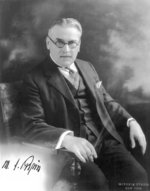Mihajlo Pupin
|
|
Mihajlo Idvorski Pupin (1854, October 9 - March 12, 1935) (A.k.a "Michael I. Pupin") Serbian physicist who devised a means of greatly extending the range of long-distance telephone communication by placing loading coils (of wire) at predetermined intervals along the transmitting wire (this research was done initially by Oliver Heaviside).
Born in the village Idvor near Pančevo, Banat, Austria-Hungary (now Serbia and Montenegro), Pupin emigrated to U.S. as a 16 year old and graduated with honors in 1883 at Columbia College, New York. Having obtained his Ph.D. at the University of Berlin in 1889, Pupin returned to Columbia University to become a teacher of mathematical physics.
Pupin's research pioneered carrier wave detection and current analysis. His 1894 invention, now known as "Pupin coil", extended the range of long-distance telephones. In 1896 he developed a method of rapid x-ray photography, requiring an exposure of only a fraction of a second, rather than that of an hour or more. In 1901, he became a professor and, in 1931, a professor emeritus of Columbia University.
In 1911 Pupin became a consul of Kingdom of Serbia in New York. In his speech to Congress on January 8, 1918, known as the Fourteen Points speech, U.S. president Woodrow Wilson, inspired by his conversations with Pupin, insisted on the restoration of Serbia and Montenegro, as well as autonomy for the peoples of the Austro-Hungarian monarchy.
Michael Pupin's autobiography, "From Immigrant to Inventor", won the Pulitzer Prize in 1924. He also wrote "The New Reformation" (1927) and "Romance of the Machine" (1930), as well as many technical papers.
Pupin was also active with the Serb émigré socities in the USA, he was the first president and founder of the Serbian National Defense Council of America (http://www.snd-us.com/).
Columbia University's Pupin Hall, the site of Pupin Physics Laboratory, is a building completed in 1927 and named after him in 1935.
There is a small crater on the Moon named in his honor.
External links
- Michael I Pupin (http://www.ieee.org/organizations/history_center/legacies/pupin.html) at IEEE History Center
- Michael I Pupin (http://www.geocities.com/neveyaakov/electro_science/pupin.html) at Eugenii Katz's Famous Scientists site
- Michael Idvorsky Pupin (http://www.imp.bg.ac.yu/mpupin/e-ndelat.htm)de:Mihajlo Pupin

